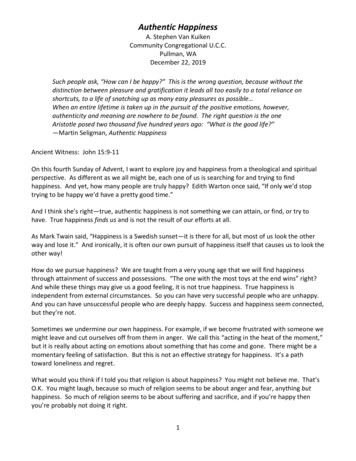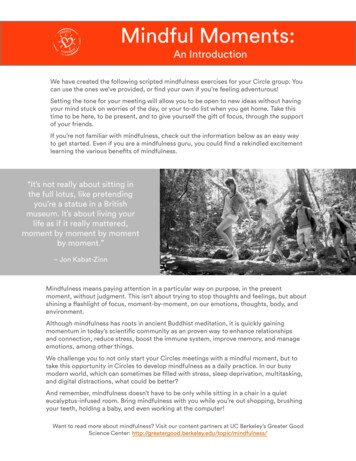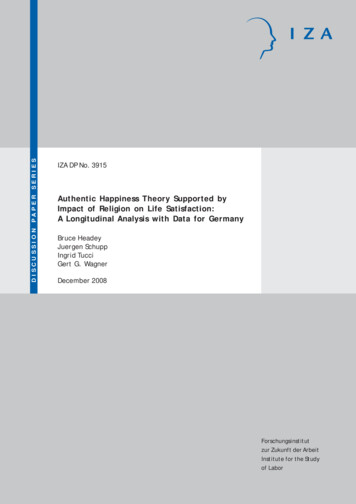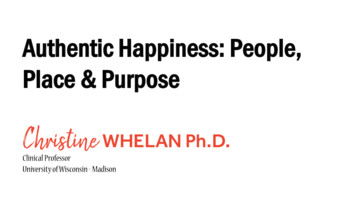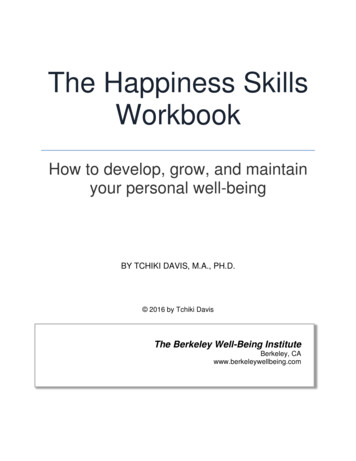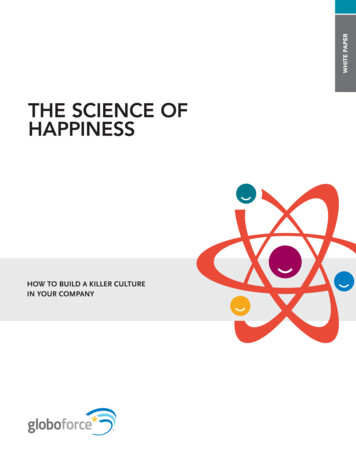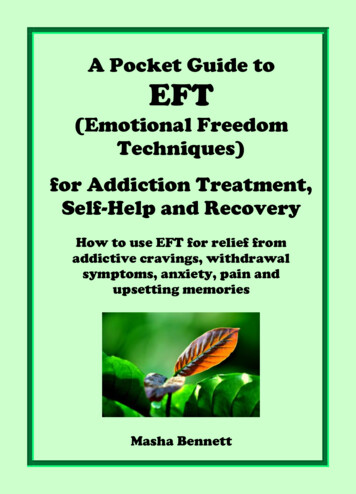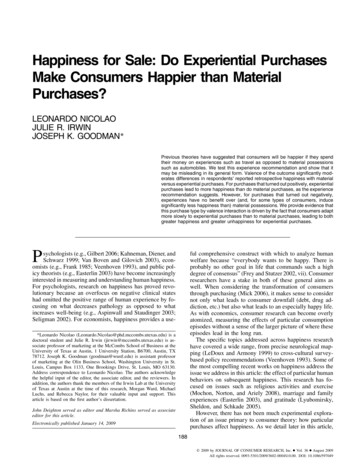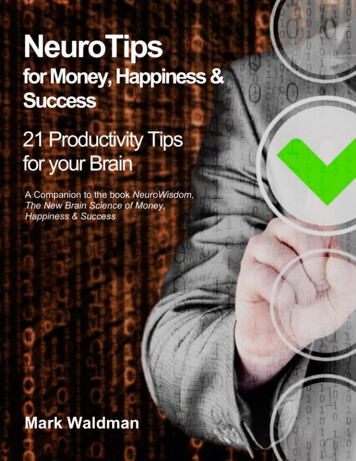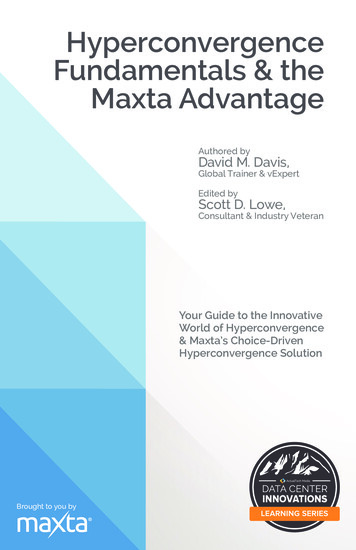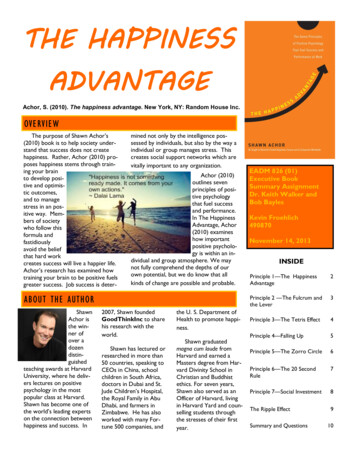
Transcription
THE HAPPINESSADVANTAGEAchor, S. (2010). The happiness advantage. New York, NY: Random House Inc.OVERVIEWThe purpose of Shawn Achor’s(2010) book is to help society understand that success does not createhappiness. Rather, Achor (2010) proposes happiness stems through training your brainto develop positive and optimistic outcomes,and to managestress in an positive way. Members of societywho follow thisformula andfastidiouslyavoid the beliefthat hard workcreates success will live a happier life.Achor’s research has examined howtraining your brain to be positive fuelsgreater success. Job success is deter-mined not only by the intelligence possessed by individuals, but also by the way aindividual or group manages stress. Thiscreates social support networks which arevitally important to any organization.Achor (2010)outlines sevenprinciples of positive psychologythat fuel successand performance.In The HappinessAdvantage, Achor(2010) examineshow importantpositive psychology is within an individual and group atmosphere. We maynot fully comprehend the depths of ourown potential, but we do know that allkinds of change are possible and probable.ABOUT THE AUTHORShawnAchor isthe winner ofover adozendistinguishedteaching awards at HarvardUniversity, where he delivers lectures on positivepsychology in the mostpopular class at Harvard.Shawn has become one ofthe world’s leading expertson the connection betweenhappiness and success. In2007, Shawn foundedGoodThinkInc to sharehis research with theworld.Shawn has lectured orresearched in more than50 countries, speaking toCEOs in China, schoolchildren in South Africa,doctors in Dubai and St.Jude Children’s Hospital,the Royal Family in AbuDhabi, and farmers inZimbabwe. He has alsoworked with many Fortune 500 companies, andthe U. S. Department ofHealth to promote happiness.Shawn graduatedmagna cum laude fromHarvard and earned aMasters degree from Harvard Divinity School inChristian and Buddhistethics. For seven years,Shawn also served as anOfficer of Harvard, livingin Harvard Yard and counselling students throughthe stresses of their firstyear.EADM 826 (01)Executive BookSummary AssignmentDr. Keith Walker andBob BaylesKevin Froehlich490870November 14, 2013INSIDEPrinciple 1—The HappinessAdvantage2Principle 2 —The Fulcrum andthe Lever3Principle 3—The Tetris Effect4Principle 4—Falling Up5Principle 5—The Zorro Circle6Principle 6—The 20 SecondRule7Principle 7—Social Investment8The Ripple Effect9Summary and Questions10
Page 2THE HAPPINESS ADVANTAGEPRINCIPLE 1—THE HAPPINESS ADVANTAGEThis principle examines theimportance of defining happiness. Happiness implies a positive mood in the present, aswell as an encouraging outlookfor the future. There is noone single meaning of happiness, but scientists refer tohappiness as ―subjective wellbeing—because it’s based onhow we each feel about ourlives‖ (as cited in Achor, 2010,p. 39).Achor (2010) shares, ―the“The Order of theElephant anyemployee can giveto another as areward for doingsomethingexemplary. „Hey,you got theelephant. What‟dyou do?‟ thegood stories andbest practices gettold and re-toldmany times”(Achor, 2010, p. 58).most successful people, theones with the competitiveedge, don’t look to happinessas some distant reward fortheir achievements, nor grindthrough their days on neutralor negative; they are the oneswho capitalize on the positiveand reap the rewards at everyturn‖ (p. 38). Happiness canimprove our physical health,which in turn keeps us working faster as well as longer,therefore making us more likely to succeed.Achor (2010) explainsthat the work environmentis key to production andsuccess is linked to reducingcosts within the workplace.Bosses and leaders who carefor their staff members andwork to foster a happyworkplace enjoy the result ofmore production and moreeffective workers. Benefitsinclude less absenteeism andlower healthcare expenditures.7 WAYS TO CAPITALIZE ON OUR HAPPINESS DA ILYAchor (2010) believesthere are a variety of ways inwhich we can create happiness in our own lives on aregular basis. Consider tryingthe following suggestions:1. Taking five minutes everyday to meditate (focusingstrictly on breathing in andout) will help reduce stresslevels in our lives.2. Finding something tolook forward to can significantly raise endorphin levels.Anticipating future rewardscan actually increase pleasurecenters in the brain, just asmuch as the reward itself.3. Creating conscious actsof kindness. Giving to friendsand strangers decreases stressand contributes to improvedmental health. Performing 5conscious acts of kindness aday is recommended.4. Infusing positivity intoour surroundings keeps negative emotions out. The lessnegative TV we watch, specifically violent media, increasesour happiness.“When we arehappy—when ourmindset and moodare positive—we aresmarter, moremotivated, and thusmore successful”(Achor, 2010, p. 37).The chicken or theegg: “Doeshappiness comebefore success orsuccess beforehappiness?(Achor, 2010, p. 41).5. Exercise not only releasesendorphins but can also boostmood and enhance work performance.6. Spend money, but not onstuff. People who buy thingsfor others feel better aboutthemselves than if they wouldhave bought something forthemselves.7. Exercise a signaturestrength. Everyone has a propensity for something. If youfind a positivity boost is in order, revisit a skill/talent/hobbyyou haven’t exercised in awhile.LEADING WITH THE HAPPINESS ADVANTAGESadly in our modern workplace,bosses and managers tend to honourthe employees who can go the longestwithout breaks or vacations, and whodo not socialize. Furthermore, quickbursts of positive emotion within thework day (visiting with colleagues,speaking to family on the phone,watching YouTube videos) which areproven to improve job performanceare yet all too often viewed as timewasters. There exists a common, negative misconception that these types ofbreaks slow the efficiency of production. Achor (2010) suggests to ridmanagement of this belief, leaders andmanagers should provide frequentrecognition and encouragement totheir teams, and understand thatbreaks, socializing, and communicationwith others is important, valuable, andnecessary to efficacy, production, andperhaps above all, happiness.Acknowledgement of specific accomplishments is found to be even moremotivating than money. The recognizedemployee will feel valued for their work,and furthermore both the person whomade the recommendation and the executive who gets to deliver the praisewill benefit from the positive celebration.Everyone gets a mood boost!
Page 3THE HAPPINESS ADVANTAGEPRINCIPLE 2—THE FULCRUM AND THE LEVERThis section examines how ourbrain has two ways of looking throughlenses. One lens is to identify thepain, negativity, stress, and uncertainty in the world. The other is to observe things through a lens of gratitude, hope, resilience, optimism, andmeaning. Although we can’t changereality, we can use our brains tochange how we process the world,and that in turn changes how we react to it.Achor (2010) reminds us thatsometimes we need to adjust ourperceptions so that we see the waysto rise above our circumstances.The fulcrum works by shifting ourattitudes and perspectives of ourselves and others. ―The most successful people adopt a mindset thatnot only makes their workdays morebearable, but also helps them worklonger, harder, and faster than theirnegative mindset peers‖ (Achor,2010, p. 71). When we reconnect ourselves with the pleasures of a job ratherthan a fretting the task at hand, ourwork ethic changes. Coming to worklooking at the positives of a job willcertainly positively impact the production and work ethic of an employee.THE LEVER OF POSSIBILITIES—FIXED VERSES GROWTH MINDSETSStudies have shown that our beliefscan affect our abilities. ―More important still than believing in yourown abilities is believing that you canimprove these abilities‖ (Achor, 2010,p. 76). With regularity, we need tofocus on our strengths rather thanreflecting to our self daunting weaknesses. Through this, researcher Carol Dweck proposed society can beplaced into two categories: the ―fixedmindset‖ and the ―growth mindset‖ (as cited in Achor, 2010, p. 76).The ―fixed mindset‖ carry the belief that their capabilities are alreadyset and they themselves cannotchange. Conversely, ―growth mindsets‖ believe they can enhance theirbasic qualities through the efforts ofthemselves and others. By changingthe way we perceive ourselves andour work, we can dramatically improve our daily results.TRY THIS:Rewrite your ―job description‖ intoa ―calling description.‖There is a different mindset thatarises when referring to a person’splace of work as ―a job‖ versus ―acalling‖. One sounds like a chore anda means to an end while the otherbears a sense of passion (Achor,2010). Our society has put pressureon our future output rather thanfocusing on the pleasures of the dailytask at hand. Achor (2010) challenges us to stop thinking of the world asfixed when in reality is, in truth, relative.CHANGING THE FULCRUM AND LEVER OF THOSE AROUND YOUOften enough, ―a few choice works canalter a person’s mindset, which in turn canalter their accomplishments‖ (Achor, 2010,p. 82). Each and every one of us has thepower to influence the performance ofthose around us, both positively and negatively. What we expect from people (andfrom ourselves) is revealed in the wordswe use. Those words can have a powerfuleffect on daily end results. The best managers and leaders view each interaction asan opportunity to prime employees fortheir own excellence.TRY THIS:―The Pygmalion Effect: when our belief in another person’s potential bringsthat potential to life‖ (Achor, 2010, p.84). The power to get results is a combination of who is on the team, as well ashow the team is leveraged by its leader.“Placebos areabout 55-60% aseffective as mostactive medicationslike aspirin andcodeine forcontrolling pain.The simple changein mindset ispowerful enoughto make theobjective symptomactually disappear”(Achor, 2010, p. 69).
Page 4THE HAPPINESS ADVANTAGEPRINCIPLE 3—THE TETRIS EFFECT―The Tetris Effect stems froma very normal physical processthat repeated playing triggersin . brains‖ (Achor, 2010, p. 88).The object of the game is to manipulate a variety of randomlydropped block shapes by movingthem side to side and rotatingthem 90 degrees with the aim ofcreating as many horizontal lineswithout any gaps as possible.The game is deceptively simple,yet surprisingly addictive.The Tetris Effect is a metaphor for being stuck—stuck in apattern of thought or behavior.People trapped in the Tetris Effect are essentially prisoners oftheir own brain as it is our brainthat dictates how we perceivethe world around us.THE TETRIS EFFECT AT WORK“We see what welook for and wemiss the rest”(Achor, 2010, p. 95).Through years of trainingin our work and personallives our brains has beenhoned to detect problemsthat arise, stresses that needmanaging, and injustices thatneed rectifying (Achor, 2010).This is of course, quite useful,but Achorcautionspeopleagainstgravitatingto a patternof alwayslooking forthe negative.Constantly scanning theworld for negatives comeswith a cost. It often undercuts our creativity, raises ourstress levels, makes us susceptible to depression and poorphysical health, and lowersour motivation and ability toaccomplish goals (Achor,2010). If we approach ourprofessions in such a fashion,it is only natural to have thatnegative outlook spill overinto the other areas of ourlives, to take that negativityhome to family members andfriends. The essence of a negative Tetris effect is that itdecreases our success rateGETTING STUCK IN A POSITIVE TETRISAccording to Achor (2010)whenwe train our brains to constantly scanfor the positive, we benefit from 3 ofthe most important tools available tous: happiness, gratitude, and optimism.1) Happiness: ―the more you pickup on the positive around you, thebetter you’ll feel advantages toperformance‖ (p. 97).2) Gratitude: ―the more opportunities for positivity we see, themore grateful we become‖ (p. 97).Studies have found that people whoare consistently grateful possessmore energy, are more emotionallyintelligent, are more forgiving, andare less likely to be anxious, depressed, or lonely (as cited inAchor, 2010).3) Optimism: ―the more your brainpicks up on the positive, the moreyou’ll expect this trend to continue,and so the more optimistic you’llbe‖ (p. 98).and debilitates our happiness.TRY THIS:Can you identify the positives in your life?The opportunities?The possibilities?The chances for growth?Can you create a habit of apositive Tetris effect?Even if you have to find faultsas a part of your profession Do you have the skillto compartmentalize yourabilities?“When we areAchorlooking for(2010) causomething, we seetions wiselyit everywhere”against overdoing positiv- (Achor, 2010, p. 96).ity, which canlead to irrational optimism, blinding usfrom problems that need fixing or improvements that should be made. ―Thekey, then, is not to completely shut outall the bad, all the time, but to have areasonable, realistic, healthy sense ofoptimism‖ (Achor, 2010, p. 104).
Page 5THE HAPPINESS ADVANTAGEPRINCIPLE 4—FALLING UP – DETERMINE HOW YOU COPE WITH STRESS/SETBACKAchor begins this chapter with ahumorous story about his own resiliency. He reminds us that all decisions we make begin from an ―I AmHere‖ point, and radiate out into acomplexity of pathways and options.―On every mental map after crisis oradversity, there are three mentalpaths. One that keeps circlingaround where you currently are Another mental path leads you toward further negative consequences And one, the Third Path,that leads us from failure or setbackto a place where we are evenstronger and more capable thanbefore the fall.‖ (Achor, 2010, p.108).Finding the right path in challenging times can be extremely difficult, leading to feelings of helplessness or hopelessness, crippling us inour failure, and crushing our
Shawn. Achor is the win- ner of over a dozen distin- guished teaching awards at Harvard University, where he deliv- ers lectures on positive psychology in the most popular class at Harvard. Shawn has become one of the world’s leading experts on the connection between happiness and success. In
